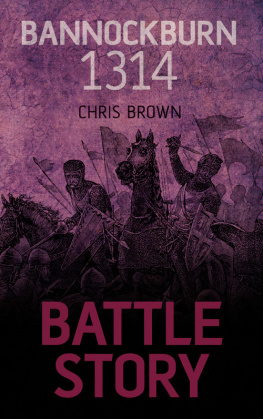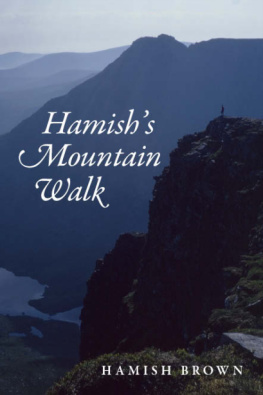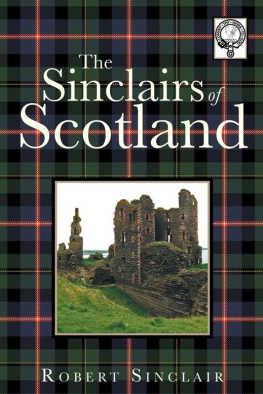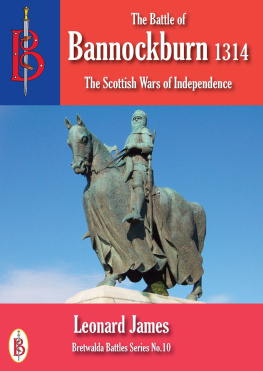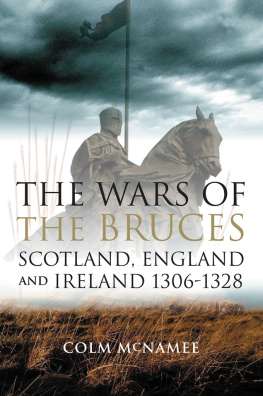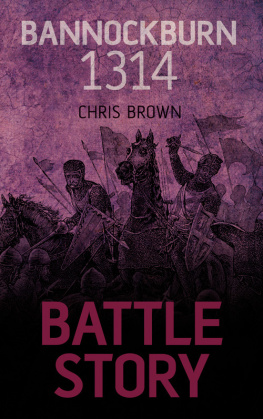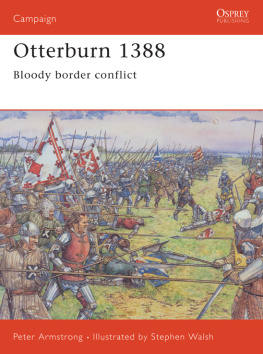
As ever, I am primarily indebted to my wife, Pat, who has borne the brunt of moaning, whingeing and frustration that is part and parcel of me writing a book, and to my editor at The History press, Jo De Vries, whose patience seemingly knows no bounds. I am also indebted to the various societies who have, from time to time, invited me to give presentations about this remarkable battle. I like to think that the many questions that I have been asked at such events have helped to make me more aware of the wide range of factors that forged the environment and influenced the processes that made things turn out the way they did. Finally, I am indebted to three kings: Edward I, Edward II and Robert I, as well as, of course, the people of fourteenth-century England and Scotland, without whom as they say none of this would have been possible.
CONTENTS
The Commanders
The Soldiers
The Tactics
Edward IIs Forces
Robert Is Forces
1. Inchcolm Abbey, where over 100 years after the event Abbott Bower penned a highly colourful description of the battle.
2. A page from Sir Thomas Greys Scalacronica .
3. The coronation of Edward I. Edward only commanded one Scottish action in person, the Battle of Falkirk, 1298. His death in 1307 was a major blow to the fortunes of the English occupation forces, however the tide of the war had probably already started to turn in favour of the Scots.
4. A sixteenth-century English artwork, depicting a fictitious parliament of Edward I attended by Llewellyn, Prince of Wales and Alexander III. Artworks and forged documents were an important weapon in the propaganda arsenals of medieval kings: the Dodgy Dossier is not a modern innovation.
5. John Balliol, from a Scottish amorial illuminated between 1581 and 1584. The king is surrounded by the broken symbols of his rule.
6. Illuminated capital from an English medieval document depicting a scene from the siege of Carlisle.
7. The obverse and reverse of the seal of Edward I.
8. Significant towns and castles in late medieval Scotland.
9. A silver penny of Robert I. Pennies of a given weight and purity of silver were known as sterlings (a term that originated from Germany) and were acceptable right across Europe.
10. The Great Seal of Robert I.
11. The memorial of Angus Og, Lord of the Isles. Although he was a vital supporter of Robert Is kingship from 1307 onward, it is not clear whether he was present at Bannockburn.
12. Detail from a Scottish grave effigy showing a fourteenth-century soldier with bascinet, padded jack and the heater-shaped shield typical of the period.
13. An assemblage of plate armour to protect the arm. Pieces as sophisticated as this one were still relatively rare in 1314 and would have been very much the province of the wealthy or of men who spent a large proportion of their time in military service.
14/15. A mail hauberk might be worn underneath a padded garment or on top of it. Opinion was divided about the relative effectiveness.
16. A re-enactor wearing the sort of brase and hose generally worn under clothing.
17. Closed helmets of this style were definitely old-fashioned by 1314, but were still serviceable and likely to have been passed on to the rank and file from better-equipped men-at-arms.
18. A selection of ordinary personal effects: a dagger, flint and steel, leather pouch, rosary and dice.
19. A man-at-arms and a spearman. The man-at-arms is wearing particularly extensive and heavy mail. By 1314 pieces of plate armour particularly at the shoulder and elbow were being added to supplement mail.
20. A chapel-de-fer or iron hat. These were widely used throughout northern and western Europe in the thirteenth and fourteenth centuries.
21. It was possible, though a little difficult, to don mail unaided. Note the thickness of the padded garment under the mail.
22. A party of medieval spearmen would have looked rather like this, though the spears would have been a good deal longer.
23. A close-up of the same party of spearmen. Although individuals were responsible for the acquisition of their own equipment, there were well-understood minimum standards which had to be observed.
24. An archer bending his bow. Although a skilled archer could hit a man at 300 yards, the arrow was unlikely to inflict serious damage on even a lightly armoured man.
25. A typical fourteenth-century archer.
26. Very few soldiers would have had the luxury of a sophisticated tent like this one.
27. With their spear points presented to the enemy in a thick hedge, a schiltrom was virtually invulnerable to cavalry attacks.
28. Articulated armour for the legs and arms was becoming increasingly common by 1314. This re-enactor is mounted on a covered or barded horse, though in the fourteenth century the barding would have consisted of several layers of cloth to reduce the effectiveness of arrows and edged weapons.
29. Grave effigy of Sir Roger de Trumpington. This image dates from about 1280; by the time of Bannockburn the absence of any plate armour other than knee protection would have made the bearer look rather outdated, but would still have been acceptable as equipment for a man-at-arms
30. Looking south from the approximate position of King Roberts division on the afternoon of 23 June.
31. The contemporary material indicates that the Scots moved down to the plain from higher ground in the New Park. They probably formed up in the area where the new Bannockburn High School stands.
32. Once the Scots had formed up they had to negotiate this steep slope before deploying on the plain.
33. A Scottish birlinn or galley. Vessels like this were used extensively by Robert I in his campaigns on the west coast of Scotland. A number of barons and other landholders were obliged to provide manned warships like this for their knight service rather than serving as mounted men-at-arms, though it was not uncommon for such men to serve in both capacities as required.
34. The Battle of Bannockburn as envisaged by Oman and Gardiner, though it bears very little resemblance to the contemporary source material.
35. The open farmland on which the main battle took place. Contrary to Victorian interpretations, all of the contemporary material makes it clear that the main engagement took place on firm ground, not among bogs and marshes.
36. The Bannock burn. The burn was probably rather wider in 1314, but even today it has a very soft and muddy floor which would be a considerable barrier to armoured men trying to escape the battlefield.
37. A view toward The Entry, where the Earls of Gloucester and Hereford made the first attack and where de Bohun was killed in a single combat with King Robert.
38. A well-equipped infantry man of the fourteenth century, with a chapel-de-fer helmet and two thin, padded garments, one under his mail and another over it.
39. The sole remaining building of Cambuskenneth Abbey. During the night of 23/24 June, the Earl of Athol mounted an attack on King Roberts stores. Of the four actions of the battle, this is the only one of which the precise location can be identified without question.
40. A well-intentioned re-enactor in the tradition of Brigadoon meets Braveheart ; however, neither kilts nor two-handed swords have any relevance to the fourteenth century.
41. The head of a battle-hammer allegedly recovered from Bannockburn battlefield.
42. Letter patent of John Balliol, acknowledging the feudal superiority of Edward I.
43. The seal of John Balliol.
44. The Pilkington Jackson statue of Robert I at the National Trust for Scotlands Bannockburn Visitor Centre.
Next page
